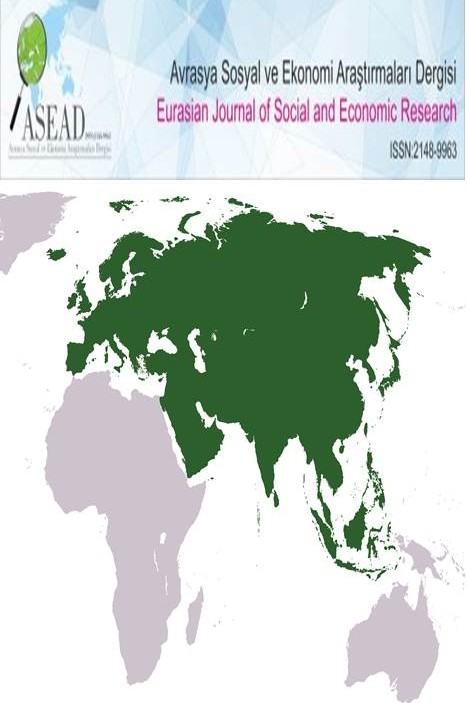FATİH WİLLİAM VE MARŞ LORTLARININ KÖKENİ
Fatih William, Marş Lortları, İngiltere, Galler, Hastings Savaşı
The Origin of the Marches Lords and Willam the Conqueror
William the Conqueror, Marcher Lords, England, Welsh, Hastings War,
___
- Alexander, M. V. C. (1998). Three Cries in Early English History: Personalities and Politics during the Norman Conquest, the Reign of King John and Wars of the Roses. Lanham: University Press of America.
- Barlow, F. (1988). The Feudal Kingdom of England 1042-1216. New York: Longman.
- ………… (1965). William I and the Norman Conquest. Londra: English Universities Press.
- Black, J. (2017). İngiltere Tarihi. (çev. Aytaç Yıldız). Ankara: Doğu-Batı Yayınları.
- ……… (2018). Kısa İngiltere Tarihi. (çev. Ekin Duru). İstanbul: Say Yayınları.
- Bloch, M. (1961). Feudal Society, (çev. L. A. Manyon). Chicago: University of Chicago Press.
- Brown, E. A. R. (1974). “The Tyranny of a Construct: Feudalism and Historians of Medieval Europe”. American Historical Review, 79 (4), 1063-1088.
- Charles-Edwards, T. M. (2013). Wale and the Britons 350-1064. Oxford: Oxford University Press.
- Chibnall, M. (1999). The Debate on the Norman Conquest. Manchester: Manchester University Press.
- ……… (2000). The Normans. Oxford: Blacwell Publishers.
- Clanchy, M. T. (1998). England and Its Rulers 1066-1272. Malden: Blackwell Publishers.
- Davies, R. R. (1979). “Kings, Lords and Liberties in the March of Wales, 1066-1272”. Transactions of the Royal Historical Society, 29, 41-61.
- ……… (1978). Lordship and Society in the March of Wales 1282-1400. Oxford: Clarendon Press.
- ……… (2000). The Age of Conquest: Wales 1063-1415. Oxford: Oxford University Press.
- Domesday Book: A Complete Translation. (ed. G. H. Martin and Ann Williams). 2003. Londra: Penguin.
- Douglas, D. (1964). William the Conqueror: The Norman Impact Upon England. Berkeley: University of California Press.
- Edwards, J. G. (1956). The Normans and the Welsh March. Oxford: Oxford University Press.
- Maitland, F. W. (1987). Domesday Book and Beyond. Cambridge: Cambridge University Press.
- Cowdrey, H.E.J. (1969). "Bishop Ermenfrid of Sion and the Penitential Ordinance following the Battle of Hastings." The Journal of Ecclesiastical History 20 (2), 225-242.
- Holden, B. W. (2008). Lords of the Central Marches. Oxford: Oxford University Press.
- Karaimamoğlu, T. – Gürsoy, S. (2021). “İngiltere’nin Yün İmparatorluğuna Dönüşme Süreci: III. Edward’ın Yün Politikası”. Gazi Osman Paşa Üniversitesi Sosyal Bilimler Araştırmaları Dergisi, 16 (2), 181-188.
- Karaimamoğlu, T.- Gümüş. T. T. (2020). “İngiliz Şövalyeliğine Dair Bazı Notlar: Dizbağı Şövalyeliği”. Orta Çağ Araştırmaları Dergisi, III (II), 356-360.
- Karaimamoğlu, T. (2022). “Norman Fethi’nden Magna Carta’ya: İngiltere’de Kralların Ölümlerinin Siyasi Sonuçları”. Manisa Celal Bayar Üniversitesi Sosyal Bilimler Dergisi, 20 (3), 113-124.
- Lieberman, M. (2010a). “The Medieval Marches of Normandy and Wales,” English Historical Review, 125 (517),1357-1381.
- ……… (2010b). The Medieval March of Wales: The Creation and Perception of a Frontier 1066-1283. Cambridge: Cambridge University Press.
- Lloyd, J. E. (1967). A History of Wales: From the Earliest Times to the Edwardian Conquest. c. 2. Londra: Longmans.
- Loyn, H.R. (1967). The Norman Conquest. New York: Harper and Row Publishers.
- Mann, K. (1996). “The March of Wales: A Question of Terminology”. Welsh History Review, 18 (1), 1-13.
- Patterson, R. B. (2002). The Scriptorium of Margam Abbey and the Scribes of Early Angevin Glamorgan (Secretarial Administration in a Welsh Marcher Barony, C. 1150-1225. Londra: The Boydell Press.
- Pease, H. (1912). The Lord Wardens of the Marches of England and Scotland. Londra: Constable and Company LTD.
- Pugh, T.B. (1963). The Marcher Lordships of South Wales 1415-1536. Cardiff: University of Wales Press.
- Reid, R. R. (1917). “The Office of Warden of the Marches: Its Origin and Early History”. The English Historical Review, 32 (128), 479-496.
- Reynolds, S. (1994). Fief and Vassals: The Medieval Evidence Reinterpreted. Oxford: Clarendon Press.
- Ridpath, G. (1876). The Border-History of England and Scotland. Londra: Printed for T. Cadeil.
- Swanton, M. (1996). The Anglo-Saxon Chornicle. New York: Routledge.
- Thomas, H. M. (2008). The Norman Conquest: England After William the Conqueror. Lanham: Rowman & Littlefield Publishers.
- Turvey, R. (2002). The Welsh Princes: The Native Rulers of Wales 1063-1283. Londra: Pearson.
- Yayın Aralığı: Yılda 4 Sayı
- Başlangıç: 2014
- Yayıncı: İrfan TÜRKOĞLU
UMUDUN PSİKOLOJİK İYİ OLUŞA ETKİSİNDE İYİMSERLİĞİN ARACILIK ROLÜ
Betül OKUDUR SABUNCU, Dilek KOCABAŞ, Ahmet Yasin ŞENYURT
ŞANGAY ÜLKELERİNDE DIŞ TİCARET AÇIĞI VE DÖViZ KURU İLİŞKİSİ
2023 CUMHURBAŞKANLIĞI VE PARLAMENTO SEÇİMLERİ: MUHALİF SEÇMENİN MUHALEFETLE İMTİHANI
CONSUMERS' PLACE PREFERENCE OF PURCHASE DURING AND AFTER THE COVID-19 PANDEMIC
SPİNOZA FELSEFESİNDE PARALELİZM, TEMSİL VE BİLGİ
SÜRDÜRÜLEBİLİR KALKINMA KONUSUNDA YAPILAN ULUSAL ALANYAZINDAKİ MAKALELERİN BİBLİYOMETRİK ANALİZİ
ORHAN PAMUK’UN KIRMIZI SAÇLI KADIN’INDA TRAGEDYANIN DOĞUŞU
YUMUŞAK GÜÇ KAPSAMINDA TEORİK BİR ANALİZ: SPOR DİPLOMASİSİ ÖRNEĞİ
THE MEDIATING ROLE OF JOB SATISFACTION IN THE IMPACT OF HAPPINESS AT WORK ON EMPLOYEE PERFORMANCE
Aysun CALIK, Fajar SURYA ARİ ANGGARA, Zaid ABU-DABBOUR, Canan YILDIRAN
